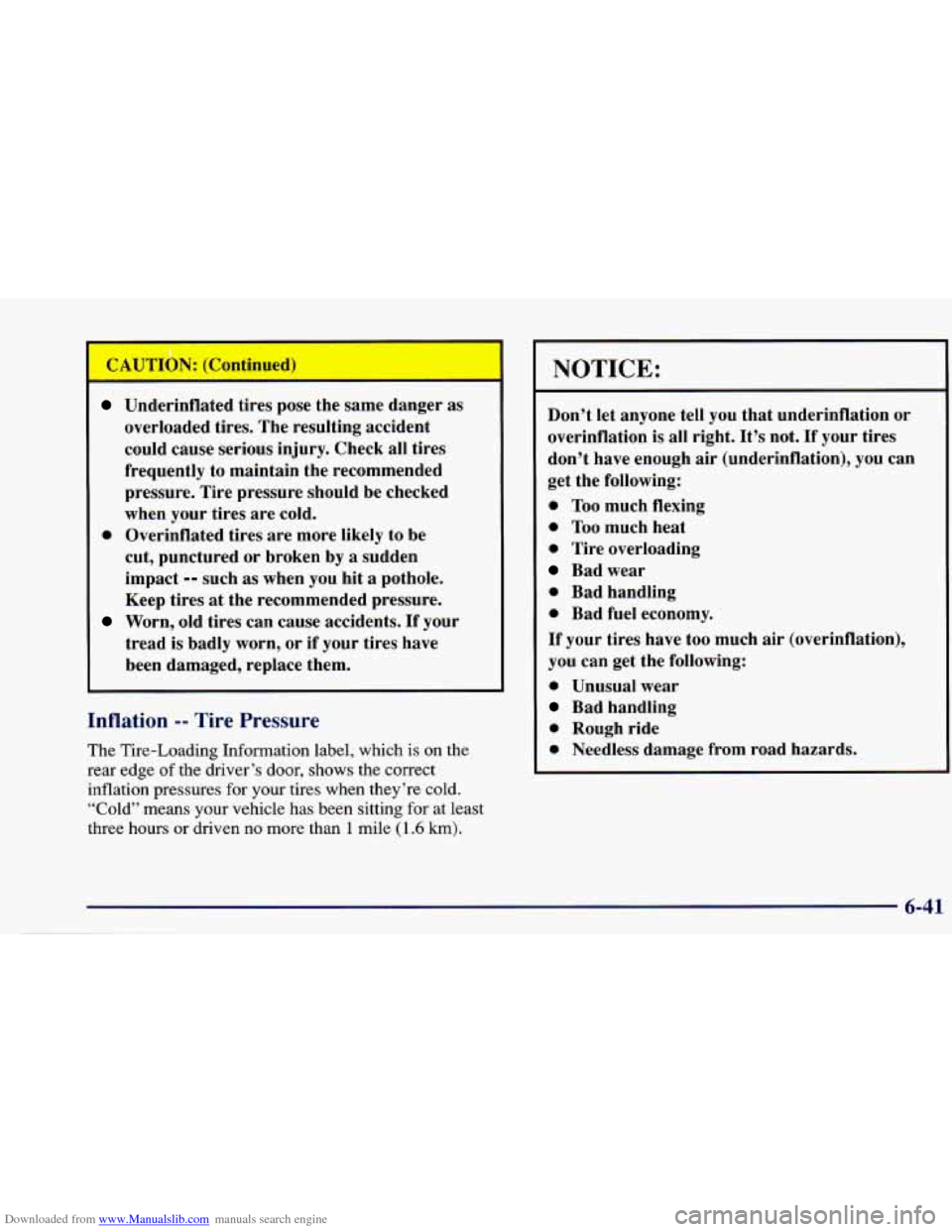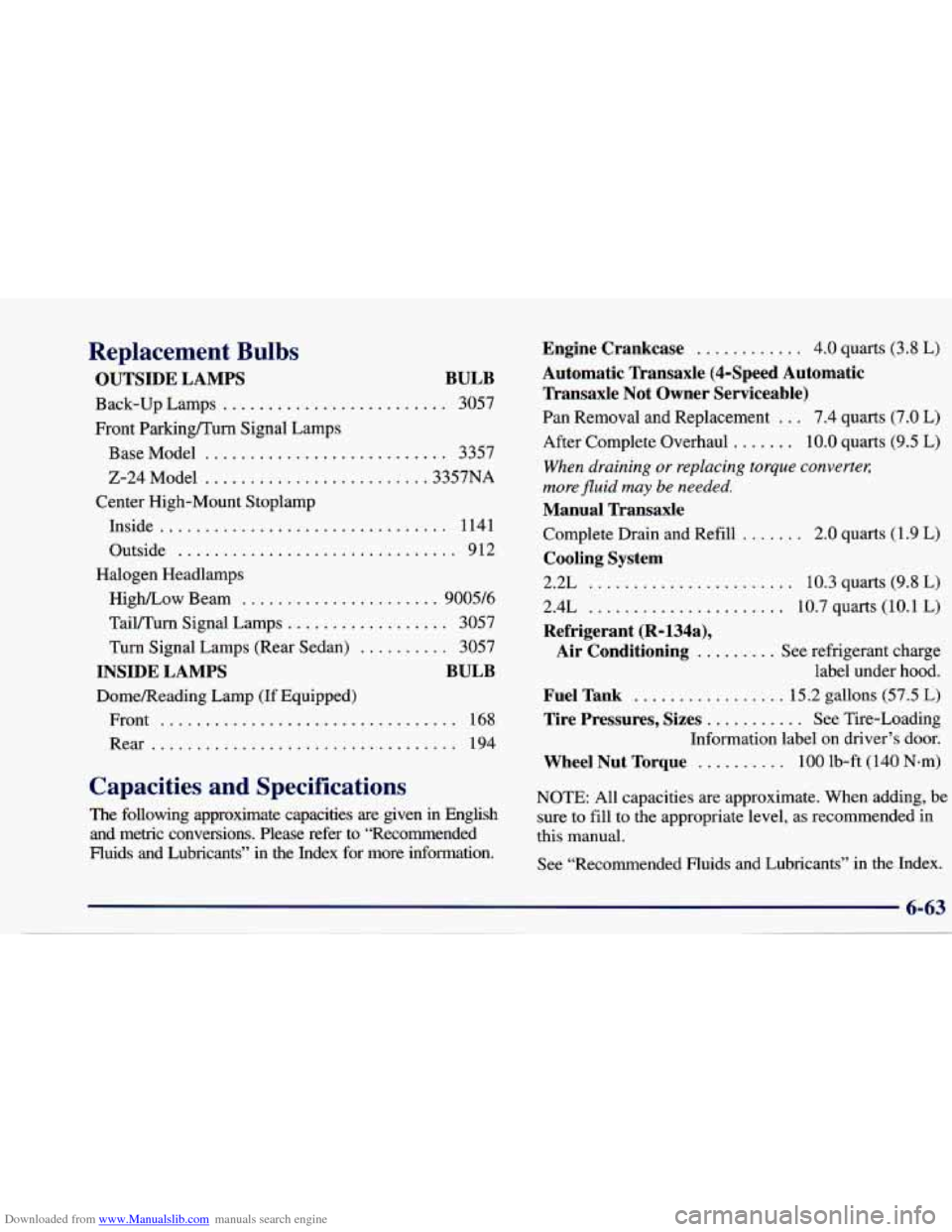Page 254 of 388
Downloaded from www.Manualslib.com manuals search engine Engine Oil
It’s a good idea to check your engine oil every time you
get fuel. In order
to get an accurate reading, the oil must
be warm and the vehicle must
be on level ground.
Check the oil here
if you
have a 2.2L engine,
Check the oil here if you have a 2.4L engine. The
dipstick’s handle will be a yellow ring.
Turn
off the engine and give the oil a few minutes to
drain back into the oil pan.
If you don’t, the oil dipstick
might not show the actual level.
Page 257 of 388

Downloaded from www.Manualslib.com manuals search engine FOR BEST FUEL I my AND COLD s 6, SELECT THE LOWEST
SAE VISCOSITY bnMur dl1 FOR THE EXkrwurw TEMPERATURE RANGE.
~~~ ~
HOT
WEATHER /- "F "C
+ 100- - t 38
+80- - +27
+60- - +16
t40- -+4
t20---7
0---la
COLD
WEATHER
LOOK
FOR '
SAL 1OW-30
I
'- 30 RED
00 NOT USE SAE 2OW-50 OR ANY OTHER GRAOE OIL NOT RECOMMENDED
As shown in the chart, SAE 5W-30 is best for your
vehicle. However, you can use
SAE 1OW-30 if it's going
to be
0°F (- 18 O C) or above. These numbers on an oil
container show its viscosity,
or thickness. Do not use
other viscosity oils, such as SAE 20W-50.
NOTICE:
Use only engine oil with the American Petroleum
Institute Certified For Gasoline Engines "Starburst" symbol. Failure
to use the
recommended oil can result in engine damage
not covered by your warranty.
GM Goodwrench@ oil meets all the requirements for
your vehicle.
If you
are in an area where the temperature falls below
-20°F (-29"C), consider using either an SAE 5W-30
synthetic oil or an
SAE OW-30 oil. Both will provide
easier cold starting and better protection for your engine
at extremely low temperatures.
6-15
Page 283 of 388

Downloaded from www.Manualslib.com manuals search engine Underinflated tires pose the same danger as
overloaded tires. The resulting accident
could cause serious injury. Check
all tires
frequently to maintain the recommended
pressure. Tire pressure should be checked
when your tires are cold.
cut, punctured or broken by
a sudden
impact
-- such as when you hit a pothole.
Keep tires at the recommended pressure.
Worn, old tires can cause accidents. If your
tread is
badly worn, or if your tires have
been damaged, replace them.
0 Overinflated tires are more likely to be
Inflation -- Tire Pressure
The Tire-Loading Information label, which is on the
rear edge of the driver’s door, shows the correct
inflation pressures
for your tires when they’re cold.
“Cold” means your vehicle has been sitting for at least
three hours or driven
no more than 1 mile (1.6 km).
NOTICE:
Don’t let anyone tell you that underinflation or
overinflation is
all right. It’s not. If your tires
don’t have enough air (underinflation), you can
get the following:
0 Too much flexing
0 Too much heat
0 Tire overloading
Bad wear
0 Bad handling
0 Bad fuel economy.
If your tires have too much
you can get the following:
0 Unusual wear
Bad handling
0 Rough ride air
(overinfl
0 Needless damage from road hazards. ati
6-41
Page 298 of 388

Downloaded from www.Manualslib.com manuals search engine Finish Damage
Any stone chips, fractures or deep scratches in the finish
should be repaired right away. Bare metal will corrode
quickly and may develop into a major repair expense.
Minor chips and scratches can be repaired with touch-up
materials available from your dealer or other service
outlets. Larger areas of finish damage can be corrected
in your dealer’s body and paint shop.
Underbody Maintenance
Chemicals used for ice and snow removal and dust
control can collect on the underbody. If these
are not
removed, accelerated corrosion (rust) can occur on
the underbody parts such as fuel lines, frame, floor
pan and exhaust system even though they have
corrosion protection.
At least every spring, flush these materials from the
underbody with plain water. Clean any areas where mud
and other debris can collect. Dirt packed in closed areas
of the frame should be loosened before being flushed.
Your dealer or
an underbody car washing system can do
this for you.
Chemic Paint Spotting
Some weather and atmospheric conditions can create
a chemical fallout. Airborne pollutants can fall upon and
attack painted surfaces on your vehicle. This damage
can take two forms: blotchy, ringlet-shaped
discolorations, and small irregular dark spots etched
into the paint surface.
Although no defect in the paint job causes this,
Chevrolet will repair, at no charge to the owner, the
surfaces of new vehicles damaged by this fallout
condition within
12 months or 12,000 miles (20 000 km)
of purchase, whichever occurs first.
6-56
Page 302 of 388
Downloaded from www.Manualslib.com manuals search engine Instrument Panel Fuse Block
The fuse panel is located under the left end of the
instrument panel.
To open, push the tab on the access
door to the left and pull the door forward. Make
sure to
insert the tabs when replacing the cover.
Fuse
TURN-B/U
F/P-INJ
CLUSTER
CLS/PCM
RR DFOG
02 HTR
Usage
Exterior Lamps, Back-up Lamps
Fuel Pump, Fuel Injectors
Instrument Cluster, Anti-Lock Brake System
Instrument Cluster, Powertrain Control Module, Daytime
Running Lights
Rear Window Defogger
Multiport Fuel Injection
Page 303 of 388

Downloaded from www.Manualslib.com manuals search engine Fuse
WIPER
ERLS
AIR BAG
EXT LAMP
PWR ACC
HVAC
RADIO
ALARM
CRUISE
L HDLP
CIG
Usage
Windshield Wipers,
Windshield Washers
Automatic Transaxle, Brake
Transaxle Shift Interlock, A/C
Compressor, Cruise Control,
Multiport Fuel Injection
Supplemental Inflatable
Restraint System
Exterior Lamps, Instrument
Panel Lights
Power Door Locks, Convertible
Top (Convertible Model)
Heater and A/C Control,
Anti-lock Brake System,
Engine Cooling Fan
Radio, Remote Keyless Entry
Alarm Module
- Interior Lamps,
Warning Chimes
Cruise Control
Left Headlamp Cigarette Lighter,
Horn, Interior
Lamps, Diagnostic Connector
Fuse
INST LPS
STOP HAZ
PWR WIN- DOW
PCM/IGN
INT LAMP
FOG LAMP
IGN
R HDLP
Usage
Instrument Panel Lights,
Warning Chimes
Exterior Lamps, Anti-Lock
Brake System, Cruise Control,
Turn Signals
Power Windows, Power Sunroof,
Convertible Top Controls
(Convertible Model)
(Circuit Breaker)
Powertrain Control Module
Alarm Module: Illuminated Entry,
Warning Chimes, Overhead
Lamps, Mapmeading Lamps,
Glove Box Lamp, Trunk Lamp,
Radio, Power Mirrors, Remote
Keyless Entry
Fog Lamps
(2-24 Only)
Engine Ignition
Right Headlamp
6-61
Page 305 of 388

Downloaded from www.Manualslib.com manuals search engine Replacement Bulbs
OUTSIDE LAMPS BULB
Back-up Lamps ......................... 3057
Front Parking/Turn Signal Lamps
BaseModel
........................... 3357
2-24Model
......................... 3357NA
Center High-Mount Stoplamp
Inside
................................ 1141
Outside
............................... 9 12
Halogen Headlamps High/Low Beam
...................... 9005/6
TaiVTurn Signal Lamps
.................. 3057
Turn Signal Lamps (Rear Sedan)
.......... 3057
INSIDE LAMPS BULB
Domemeading Lamp (If Equipped)
Front
................................. 168
Re x.................................. 194
Capacities and Specifications
The following approximate capacities are given in English
and metric conversions.
Please refer to “Recommended
Huids
and Lubricants” in the Index for more information.
Engine Crankcase ............ 4.0 quarts (3.8 L)
Automatic Transaxle (4-Speed Automatic
Transaxle Not Owner Serviceable)
Pan Removal and Replacement ... 7.4 quarts (7.0 L)
After Complete Overhaul ....... 10.0 quarts (9.5 L)
When draining or replacing torque converter;
more fluid may be needed.
Manual Transaxle
Complete Drain and Refill ....... 2.0 quarts (1.9 L)
Cooling System
2.2L ....................... 10.3 quarts (9.8 L)
2.4L
...................... 10.7 quarts (10.1 L)
Refrigerant (R=134a),
Air Conditioning
......... See refrigerant charge
label under hood.
Fuel Tank ................. 15.2 gallons (57.5 L)
Tire Pressures, Sizes ........... See Tire-Loading
Information label
on driver’s door.
Wheel Nut Torque .......... 100 lb-ft (140 Nem)
NOTE: All capacities are approximate. When adding, be
sure to fill to the appropriate level, as recommended in
this manual.
See “Recommended Fluids and Lubricants” in the Index.
Page 309 of 388
Downloaded from www.Manualslib.com manuals search engine 0 Section 7 Maintenance Schedule
This section covers the maintenance required for your Chevrolet. Your vehicle needs these services to retain its safety,
dependability and emission control performance.
7-2
7-2
7-3
7-4
7-4
7-4 7-4
1
7-4 1
7-4 1
7-42
7-43
Introduction Your Vehicle and the Environment
How This Section
is Organized
Part A: Scheduled Maintenance Services
Using Your Maintenance Schedule
Selecting the Right Schedule
Part B: Owner Checks and Services
At Each Fuel Fill
At Least Once
a Month
At Least Twice
a Year
At Least Once a Year
7-46
7-46
7-46
7-46
7-46
7-47
7-47
7-48
7-50 Part C: Periodic Maintenance Inspections
Steering, Suspension and Front Drive Axle
Boot and Seal Inspection
Exhaust System Inspection
Radiator and Heater Hose Inspection
Throttle Linkage Inspection
Brake System Inspection
CaliperKnuckle Maintenance Inspection
Part
D: Recommended Fluids and Lubricants
Part E: Maintenance Record